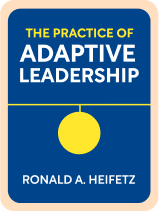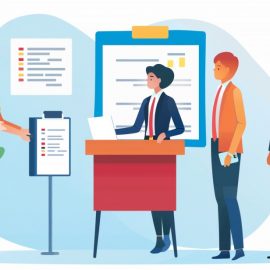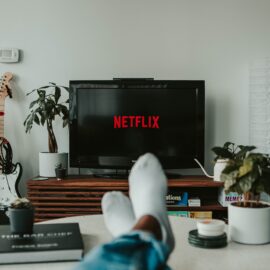

This article is an excerpt from the Shortform book guide to "The Practice of Adaptive Leadership" by Ronald A. Heifetz. Shortform has the world's best summaries and analyses of books you should be reading.
Like this article? Sign up for a free trial here .
What exactly is an adaptive change? Have you ever introduced a fundamental change to your organization’s processes? How did you communicate it to your team?
According to change theorist Ronald A. Heifetz, an adaptive change is a change instituted in response to an “adaptive challenge”—an organizational problem that has no known solutions. Part of your job as an adaptive leader is to prepare people for the change, and the first step to this is to make sure that everyone has an accurate understanding of what the challenge entails and what change is about to come.
In this article, we’ll look at how to manage others by shaping their interpretations of the adaptive change. Since people changing is a key ingredient of adaptive change, the treatment tips are all people-related.
Preparing for an Adaptive Change
People (including you) have to change to carry out adaptive change. However, organizations, teams, and individuals often default to interpretations of problems that don’t require change or for them to take responsibility. Default interpretations aren’t always wrong, but they usually don’t capture the full picture—which is necessary for adaptive change.
- For example, when companies are losing market share, many middle managers interpret this as senior management failing to innovate. If the fault is senior management’s (it could be partially), then middle managers don’t have to make any changes to their own work. In reality, though, everyone will need to change to reach an adaptive solution.
These default interpretations might be related to a departmental perspective on the problem. For example, often, senior leaders cement default interpretations by gravitating towards them or minimizing other interpretations.
As an adaptive leader, part of your job is to shift people’s interpretations towards what’s most accurate, not what’s easiest to swallow. When you concretely describe a complicated problem, this helps people find their footing and focus. Even if they don’t agree with your interpretation, having something concrete to discuss will spark work towards solving the problem.
People’s interpretations usually need to shift in the following three directions:
Direction #1: Technical to adaptive. Teach everyone at your organization the difference between technical and adaptive challenges so that they realize the different types require different solutions. This will help them understand:
- That when you’re giving orders, it’s because the problem is technical, not because you’re a dictator
- That when you’re asking questions and experimenting, it’s because the problem is adaptive, not because you’re wishy-washy
Direction #2: Benevolent to conflict-laden. Once people understand what adaptive challenges are, they’ll start to understand that they inherently involve loss and there’s no point in avoiding it—what they need to do is acknowledge conflicts, assess which losses are acceptable, and then move forward.
Direction #3: Personal to organizational. Problems are usually greater than one person is experiencing—there’s something about the system (that needs to be adapted) that allows them to persist. (For example, the fact that you have to deal with an underperforming employee might be because the organization’s culture protects underperforming employees.) Once people realize the problem exists outside themselves, they can start to assess how everyone in the organization is affected by it.
To get people to make these shifts, try the following five techniques:
Technique #1: Change the Default Interpretation From Personal to Organizational
The first technique rewires people’s defaults so that they think first about how the problem is organizational, rather than how it’s personal. (If it were only personal, not everyone would have to change.)
To do this:
1. Determine the default, personalized interpretation of the groups a person belongs to. To do this, watch how the group responds to problems and situations and try to identify a pattern.
2. State the default. There are two ways to do this:
- Direct. If the group can tolerate discomfort, flat-out tell them what you think their default interpretation is and how it’s limiting them.
- Indirect. If the group balks at discomfort, ask questions that will prompt the group to start discovering the default on their own:
- What assumptions are we making about this problem? Are they accurate? Can we test them to find out?
- Is there another way to view this problem?
- The problem affects others in the organization too—how do they view it?
Technique #2: Regularly Ask Questions
The next technique is to ask people more questions. This pushes them further beyond their default interpretations and helps them open themselves to adaptive change.
Ask these questions:
- Is there something about this problem that’s new and different from what we’ve seen before, and therefore might need a new and different solution?
- Who are the major players in the problem, and how do they see the situation? What are the stakes for them, both from your perspective and theirs?
- Do people in the organization feel the problem is urgent?
- What parts of the problem are technical and which are adaptive?
- Are other people, whether within or outside the organization, facing a similar problem? How are they handling it?
Technique #3: Spark Many Interpretations
The third technique is to keep pushing people to interpret. Even once people have moved beyond their default interpretation, they’ll probably still be inclined to assign only one interpretation to a given situation, which limits their ability to work towards adaptive change.
People usually stop at one interpretation because:
- One interpretation fits their values or interests. For example, in a struggling law firm, the newer hires think the slowed growth is because the careerists don’t work as hard anymore, and the careerists think it’s because the new hires aren’t properly integrated.
- Other interpretations appear to come with more loss. For example, the careerists don’t want to lose the benefits that come with seniority, so resist interpretations that threaten that.
- Other interpretations appear to come with more conflict. For example, the firm might favor the interpretation that they need to invite a new hire to join the management committee, instead of addressing the conflict between the two groups.
- They’re not ready to deal with the problem. For example, choosing an interpretation that focuses on integration allows the firm to ignore the careerists whose performance has slid.
Acknowledging only one interpretation only gives you one angle from which to approach the adaptive problem. To generate more solutions, you need to generate more interpretations, the more diverse the better, because this allows for a complete and accurate view of the situation. This can be messy, create conflict, and take time, but in the long run, it’s more efficient and innovative.
There are two ways to encourage more interpretation:
1. Ask what-if questions about the existing interpretations.
- For example, if the interpretation is that the company is losing market share because customers prefer competitors’ products, which have more features, one of the only solutions is to add new features to your product. To generate other solutions to the problem of losing market share, ask, “What if customers actually don’t care about new features?” This will force people to consider what customers do value and if there are other possible explanations for the loss of market share.
2. Make a structural change that facilitates multiple perspectives.
- For example, when the authors’ consulting practice assigned only one consultant to a firm, at debriefing meetings, there was only one perspective. They started assigning at least two people so that they got multiple perspectives and interpretations.
Once you’ve generated more interpretations, your job is to encourage people to keep considering all of them. One way to do this is to share the responsibility for evaluating interpretations.
- For example, divide the group into teams and put each team in charge of coming up with solutions to different interpretations. Then, share everyone’s work. Notice which interpretations and solutions make people uncomfortable or generate energy. With the help of the team, come up with some experiments that could help test which interpretations are the most accurate—including the uncomfortable ones.
Technique #4: Call People Out When They Regress to Their Default Interpretations
The fourth technique is to maintain the progress you’ve made in using the above techniques by calling out people who regress to their default interpretations. People regress for two reasons:
- They want an easier solution (adaptive solutions are harder).
- They gather new information from their immediate surroundings rather than taking a step back and considering the whole organization. This skews their interpretation.
Here are some signs that people are regressing and how to respond:
- They complain about senior leadership. This suggests that they think the problem is with the leaders as people, not the company’s strategy or vision. To push them back in the right direction, ask what pressures and expectations the leaders are facing.
- They talk about how quickly the problem will be fixed, which suggests they’re focusing on short-term solutions. To push them forward, ask them if they think the company has the fortitude to deal with the cause rather than soothe a symptom.
- They talk about how easy it will be to solve the problem, which suggests they see it as technical. To push them forward, suggest that hiring a consultant well-versed in technical issues might not work.
- They lament about failure to execute ideas, which suggests that they think the problem is execution, not the idea itself. In response, suggest that even though the organization is passionate about their idea, the market might not be.
- They say everyone will win in the end, which suggests they think that there will be no losses. In response, ask them what the people who oppose the solution fear losing.
Technique #5: Address Your Own Defaults
The final technique is to zoom in on yourself—like everyone, you have defaults too. To avoid getting too attached to your defaults, which will limit your ability to change, think of presenting them like auditioning for a part in a play. During the audition, you’re playing a character who’s invested and passionate in the interpretation, but once the audition is over, let go of your investment.
Watch how others react (or don’t) to your interpretation and solicit feedback. Don’t defend your interpretation, because this will stifle discussion.
- For example, one firm was having a problem with women leaving. One employee suggested that it was because the firm tended to be aggressive and direct, which favored men over women. Then, he went quiet and, rather than defending his view, let everyone else react (which they did with aggression and directness). This showed him that his interpretation might be correct.

———End of Preview———
Like what you just read? Read the rest of the world's best book summary and analysis of Ronald A. Heifetz's "The Practice of Adaptive Leadership" at Shortform .
Here's what you'll find in our full The Practice of Adaptive Leadership summary :
- How to deal with unknown solutions that require innovation, experimentation, and adaptation
- How to determine if a problem is technical or adaptive
- Five tips for launching initiatives to address adaptive challenges






